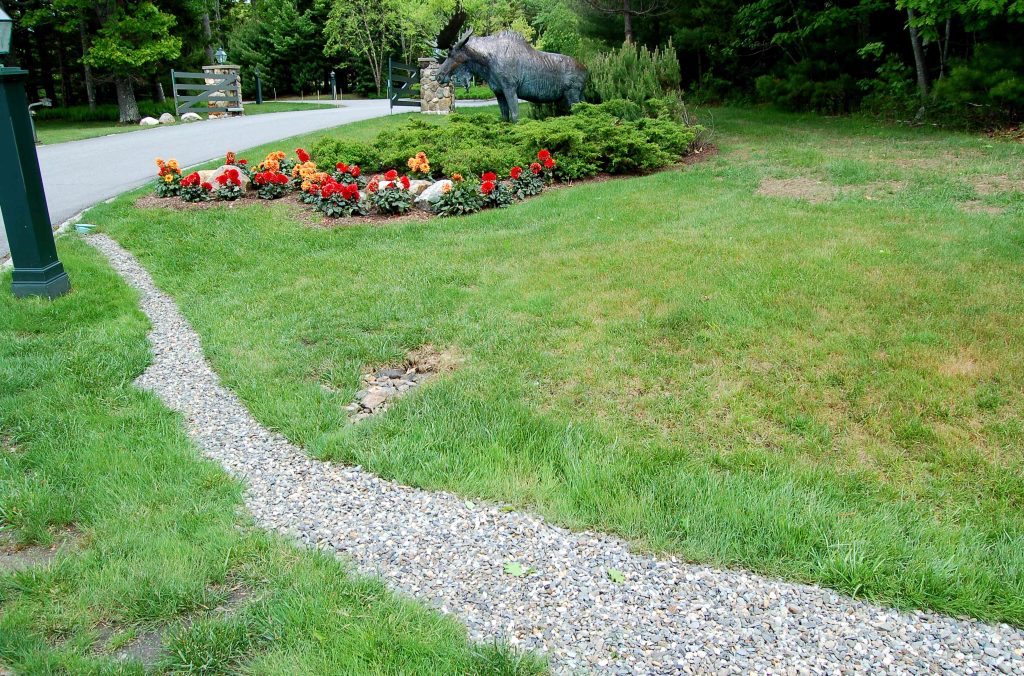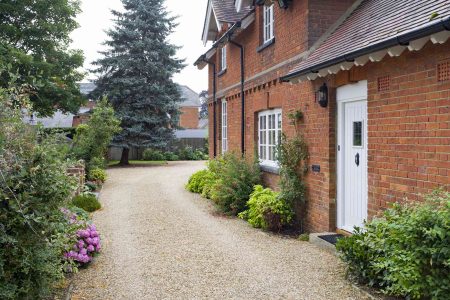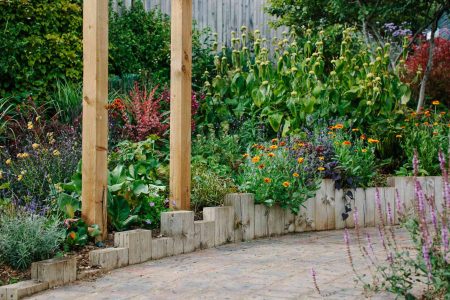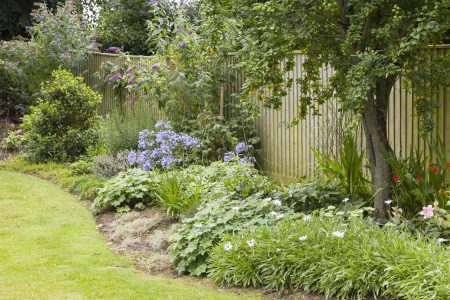There are different types of French drains, and the types used in landscaping are for dealing with excess surface water. For example, if your neighbor’s land stands at a higher elevation than yours, you might get water runoff from your neighbor after a heavy rain. Because you can’t change the neighbor’s land, you need better yard drainage to deal with all the water. A French drain is a common and inexpensive solution.
What Is a French Drain?
A landscaping French drain is a gravel-filled trench that’s lined with landscape fabric to keep soil and silt out of the gravel. While some types of these drains include a perforated drain pipe (also called drain tile) and may be covered with grass, the traditional French drain is simpler with no drain pipe and gravel running all the way to its surface.
With a French drain, surface water flows into the trench, where it freely moves through the gravel. The bottom of the trench is sloped slightly, so gravity carries the water to an exit point at the end of the trench. At the exit point, the water can be collected in a large swale or a dry well, or it can simply flow into a suitable drainage area or a rain garden.
Codes and Regulations
Yard drainage projects might be restricted by local building codes, zoning laws, or community rules. Always confirm your plans with the local building and zoning authority and homeowners association as applicable. It can be unlawful to direct water runoff from your property into stormwater systems. If your plan is not approved, you might be able to use an alternative drainage system, such as a dry well, to keep the drainage water on your property and let it soak into the ground rather than flow over the surface.
What You’ll Need
Equipment / Tools
- Hammer
- Mason’s line
- Line level
- Tape measure
- Square spade
- Digging shovel
- Utility knife
- Bow rake
Materials
- Wood stakes
- Landscape fabric
- Landscape fabric staples
- Crushed granite
Instructions
Instructions
-
Determine a Trench Location
Assess the flood-prone area(s) of your yard to determine a general location and route for your French drain. Most important, determine where the water should go, and confirm that the exit or drainage end of the trench is in a suitable location. Also consider the practical effects of an exposed gravel channel in the yard: How might it affect traffic routes, views, or recreation areas?
-
Gain Permission
Confirm that your yard drainage will not adversely impact anyone else’s land or any public areas, which could lead to legal problems. Check with your city’s building authority to make sure your plans conform to local law. Call 8-1-1 (the national “Call Before You Dig,” or “Dig Safe,” hotline) to have all underground utility lines marked on your property. This is essential before doing any digging.
-
Check the Slope
A French drain must be sloped to carry the water down to its destination. A minimum slope of 1 percent (that is, a drop of 1 foot for every 100 feet in length) is recommended. It’s fine if your yard creates a natural slope that is steeper; just be aware that steepness increases water velocity and can lead to more erosion in the discharge area.
Check the natural slope by driving a stake at the beginning and end of the planned trench route. Tie a mason’s line tightly to one of the stakes; then run it over to the other stake and tie it off loosely. Attach a line level to the line. Detach the loose end of the line, pull the line taut, adjust it so it is level, and tie it securely to its stake. Measure straight down from the line to the ground at regular intervals (every 4 feet, or so) to see how the slope changes. You can adjust the depth of the trench as needed to create the desired slope; working against a natural slope just means more digging.
-
Dig the Trench
Reset the stakes and level line, if necessary, so the line runs down the center of the planned trench. Begin digging the trench by cutting a straight line through the sod, 3 inches (or as desired) to one side of the line using a square garden spade. Repeat the same process on the other side, also 3 inches from the line, for a total trench width of 6 inches (or as desired). Remove the sod, then dig the trench, creating vertical sides and a smooth, sloped bottom.
Measure down from the line frequently as you work to check the slope of the trench bottom. Remember, you’re measuring into the trench, not to the ground surface. Make the trench as deep as desired. For example, a 50-foot-long trench might be 8 to 10 inches deep at the starting end and 14 to 16 inches deep at the exit point (assuming the natural slope is relatively flat). Compact and smooth the bottom of the trench as you go.
-
Line the Trench With Fabric
Line the trench with landscape fabric using a continuous swath if possible. Otherwise, overlap pieces of fabric by at least 12 inches and secure the ends with fabric staples driven into the ground with a hammer. Secure both ends of the fabric with staples. Fold back excess fabric to both sides of the trench; you will trim it to fit later.
-
Fill the Trench
Fill the trench with course drainage gravel, such as crushed granite, so it is flush with the surrounding ground or sod. Rake the top of the gravel so it is smooth and even with the top of the trench. Alternatively, you can overfill the trench slightly and rake the gravel into a mound (highest in the center) so the trench is more visible. Trim excess landscape fabric along the edges of the trench using a utility knife.
When to Call a Professional
Call a professional if excess surface water runs or collects near your house or leads to seasonal flooding inside the house. Likewise, seek expert advice if your planned trench route brings water near (or even closer to) your house or might affect natural runoff patterns. Improperly designed drainage systems can do more harm than good. Significant drainage problems may call for regrading of large areas of the landscape, and this requires engineering and heavy equipment.
-
What is a French drain?
A French drain is a trench composed of landscape fabric and gravel that helps to direct surface water. It is used to prevent water pooling, as well as to direct water away from home foundations and other structures.
-
How deep does a French drain need to be?
French drains are generally around 8 inches to 2 feet deep. The depth can be adjusted along the drain to create a slope.
-
Can you cover a French drain with dirt?
No. Dirt will clog up the French drain’s gravel and prevent it from functioning properly.
Read the full article here














